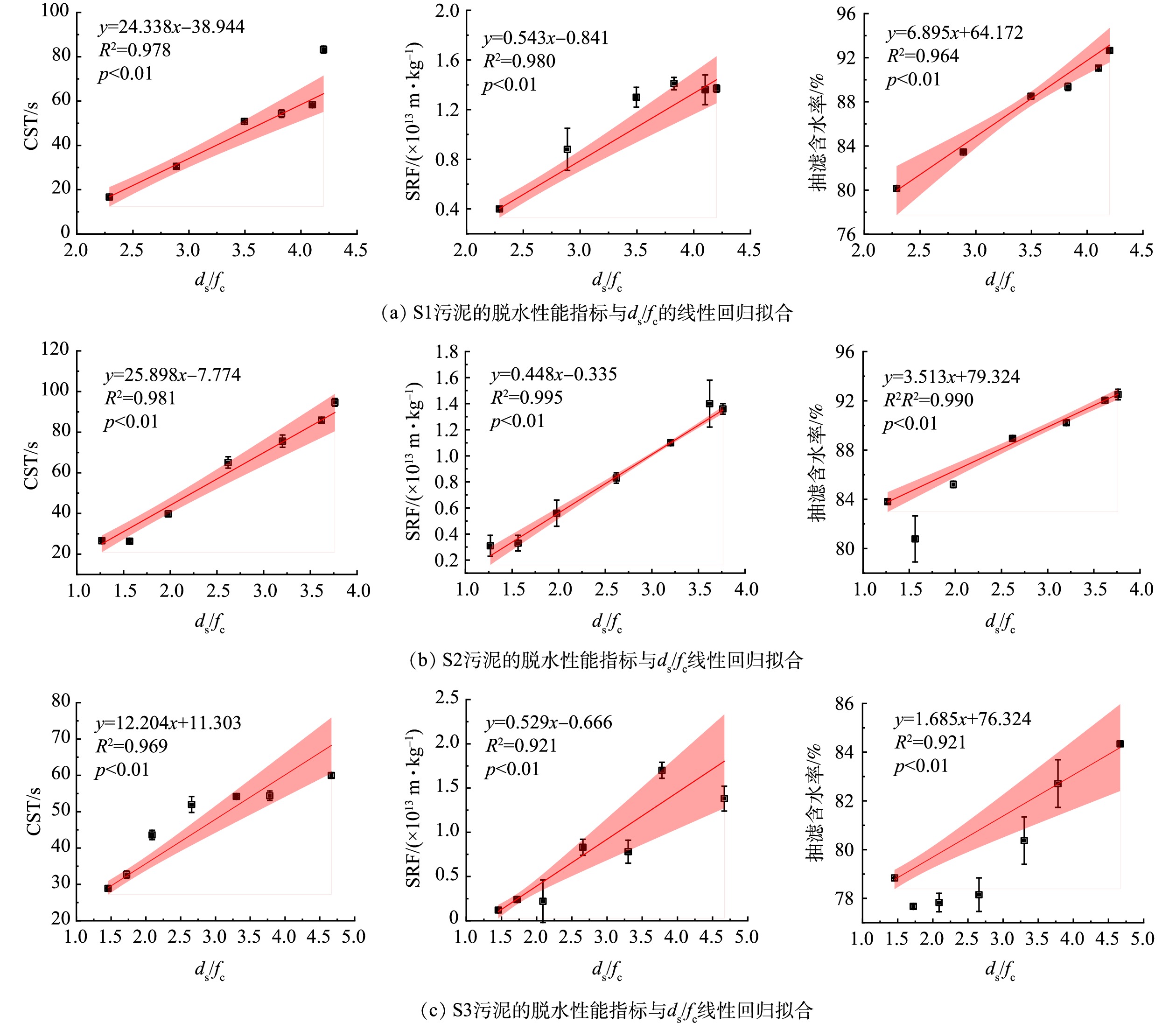-
随着我国城镇生活污水处理量的日益增加,污泥处理处置问题越来越受到社会的关注。截至2019年底,我国污泥产生量已超过6 000×104 t(以含水率80%计),预计2025年将突破9 000×104 t[1]。作为污水处理过程的副产物,剩余活性污泥含水率较高,组成复杂,呈类凝胶结构,存在脱水困难的问题[2]。为改善污泥脱水性能,需要投加药剂对其进行调理,而调理药剂的费用占污水处理厂运行费用的比例可达20%[3-4],显著影响了污水处理厂的运行。因此,实时反馈污泥脱水性能、精确控制调理药剂的投加具有一定的现实意义。
污泥的流变学测量常用于间接确定污泥调理的最佳投药量,国内外多位学者通过监测污泥流变学参数(粘度、初始峰值、剪切模量、总扭矩)反馈污泥脱水性能、预测污泥调理过程中的聚丙烯酰胺(PAM)投加量[5-8]。WANG等[9]通过Floccky和Haake RV20流变仪研究了阳离子聚丙烯酰胺(CPAM)调理对消化污泥流变特性的影响,发现2种流变图中初始峰值和面积的最大值所对应的CPAM投加量与优化出的CPAM最佳投药量接近。OLIVEIRA等[10]采用流变学参数监测了污泥脱水性能的变化,发现污泥的剪切粘度可以反馈污泥脱水性能。然而,在污泥调理过程中,在线测量流变参数尚未实现,流变模型的选择亦较为主观,高度依赖于实验条件(剪切速率、污泥种类等),另外,流变仪结构精密、价格昂贵,限制了其在污泥调理中的应用[11]。因此,仍需进一步研究能够实时反馈污泥脱水性的相关技术。
电化学阻抗谱(electro chemical impedance spectroscopy, EIS)是一种通过对电场微扰动的监测来在较大频率范围内测量系统阻抗(交流电势与电流信号的比值)的方法[12],具有检测精确且无损的优点,被广泛应用于生物、电池、半导体材料等领域[13-15]。DIEUDE等[16]研究了污泥流变和电化学特性之间的联系,发现在温度变化的条件下,污泥的粘度和电化学阻抗模量Z之间呈线性关系,并且电化学参数有望实现现场在线测量。SEFALEN等[17-18]研究了污泥的含固率和温度2种因素分别对污泥流变和电学特征的影响。结果表明,污泥的表观粘度随着污泥含固率的升高、温度的降低而升高,其导电性则随着污泥含固率的升高、温度的升高而升高。虽然已有的研究对污泥流变学特征与电化学特征之间的联系进行了分析,但均未涉及到污泥混凝调理的过程,且污泥的电化学阻抗特征能否用来指示脱水性能尚未可知[19]。
本研究选取FeCl3作为调理药剂,对北京3座具有不同处理工艺的污水处理厂的剩余活性污泥进行混凝调理,考察FeCl3投加量对剩余活性污泥脱水性能、理化性质和电化学阻抗谱的影响,探讨剩余活性污泥脱水性能参数与电化学阻抗谱参数之间的关联关系,判断电化学阻抗谱参数指示污泥脱水性能的可行性。
-
本实验所用剩余活性污泥分别取自北京3处不同处理工艺的污水处理厂。所取得的污泥在2 h内运至实验室,重力沉降4 h,弃去上清液,将沉淀的污泥通过孔径为0.18 cm的网筛进行过滤。收集过滤后的污泥置于(4.0±0.5) ℃冰箱备用。本研究共采集3批污泥样品进行实验。污泥基本性质如表1所示。为保证污泥性质不发生改变,每批污泥所做的实验均在7 d内完成。
-
1) FeCl3混凝调理污泥。取350 mL剩余活性污泥于500 mL烧杯中,置于六联搅拌器(JTY-6)下,然后投入一定量的固体FeCl3·6H2O,在300 r·min−1的转速下快搅2 min,使其充分溶解并分散到污泥中;之后,以60 r·min−1的转速慢搅拌5 min而发生混凝作用;静置30 min后,测定污泥样品的毛细吸水时间(CST)、抽滤含水率、比阻(SRF)。
2)污泥电化学阻抗测定。采用电化学分析仪(IM3570, HIOKI)连接电导率电极(Tetracon325, WTW)对污泥样品进行电阻抗谱分析。将调理后的污泥样品置于加热磁力搅拌器上,设置温度25 ℃,转速420 r·min−1,待污泥样品稳定后,将电化学分析仪施加50 mV的正弦波电压,在4 Hz到5 MHz的频率范围内对污泥样品进行扫描。测量时,探头插入深度应保证污泥样品没过电极的接触圆片,测量至少重复3次。
-
1)脱水性能。污泥CST通过CST测定仪(304B, Triton127 Electronic Co, UK)进行测定。SRF采用抽滤装置,取100 mL调理后污泥,均匀倒入布氏漏斗内,在真空压力0.038 MPa下记录滤液体积,测定抽滤后泥饼的含水率,并计算相应的SRF[20]。
2)理化性质。Zeta电位通过基于多普勒电泳光散射分析技术的Zeta电位仪(Malvern Zetasizer Nano, UK)测定;pH采用pH计(PB10,瑞士Mettler Toledo)测定;电导率采用电导率仪(EC215, Conductivity Meter)测定。含水率、悬浮固体含量(TSS)等测定参考文献[21]。
3)电化学阻抗。电化学阻抗测量得到污泥阻抗的实部和虚部,共采集201个点[19]。按下述程序进行数据处理[22]:首先,用各扫描频率下的阻抗模量|Z|(阻抗实部和虚部的平方根)分别减去最大扫描频率下的阻抗模量得到校正后的阻抗模量|Zc|[22];之后,将电化学分析仪扫描得到的阻抗实部与虚部另存为txt文本导入Zview软件中,选取其中的10 000 Hz~2 MHz的数据进行等效电路拟合得到Rt、Cp,根据式(1)[23]求得临界频率fc;最后,选取扫描得到的点中大于临界频率fc的点的频率f和|Zc|,进行IFFT和FFT的数学变换,之后选取结果中的频率f和振幅平方P,根据式(2)[23]求得ds。
式中:fc为临界频率,Hz [22];Rt为电荷转移电阻,Ohm;Cp为双电层电容,F;P为扫描到的阻抗振幅的平方;f为扫描频率,Hz;ds为污泥絮体的阻抗谱维数。为避免污泥絮体颗粒不同导致的ds差异,将扫描得到的阻抗谱维数ds除以式(1)[23]求得的临界频率fc,得到标准化后的污泥电化学阻抗谱参数ds/fc。
4)数据统计与分析。采用SPSS 25.0统计软件,对污泥CST、SRF、抽滤含水率及ds/fc数据的正态性进行检验,应用K-S检验判断数据是否符合正态分布,对符合正态分布的数据进行Pearson相关性分析。以ds/fc为自变量,以污泥的脱水性能为因变量,做线性回归分析,尝试用ds/fc对污泥的脱水性能进行预测。
-
图1为剩余活性污泥的脱水性能指标随FeCl3投加量的变化曲线。随着FeCl3投加量的增加,各污水处理厂剩余活性污泥的CST和SRF呈下降趋势,脱水性能得到明显改善。当FeCl3投药量为100 mg·g−1时,S1污泥的CST、抽滤含水率、SRF均达到最小值,CST由83.2 s降至16.7 s。S2污泥的CST、抽滤含水率、SRF大幅下降,继续投加FeCl3,S2污泥的CST和SRF基本不变,但其抽滤含水率上升。这可能是由于FeCl3投加量过大时,污泥絮体的Zeta电位趋向于0,使污泥絮体更易于聚集。污泥絮体的粒度增长虽然有利于抽滤脱水,但大量的Fe(III)及其水解组分的存在可能会增加污泥的亲水性或含水率。S3污泥的CST值仍呈下降趋势,SRF和抽滤含水率基本稳定。当投药量进一步增加,超过150 mg·g−1时,S3污泥的亲水性越来越强,沉降性能和脱水性能变差,因而不利于抽滤,抽滤含水率小幅上升[24]。综上所述,可以确定,FeCl3调理活性污泥的较适投加量为100 mg·g−1,此时S1、S2、S3污泥的CST值较原泥分别下降了79.93%、72.23%、27.33%。
-
FeCl3调理前后剩余活性污泥电导率和Zeta电位的变化如图2所示。随着FeCl3投加量的增加,污泥絮体由于电性中和作用快速絮凝,剩余活性污泥絮体表面所带负电荷被迅速中和,Zeta电位上升,并逐渐接近于0。曾祥国[25]的研究中选用FeCl3对污泥进行调理,发现随着FeCl3的加入,污泥表面的负电荷被中和,污泥絮体间的排斥作用减弱,污泥的脱水性能明显改善。这与本研究结果一致。此外,由图2可看出,各污水处理厂污泥的电导率随FeCl3投加量的增加持续上升。当投药量为100 mg·g−1时,S1、S2、S3污泥的电导率分别为2.92、5.94、3.56 mS·cm−1,相比原泥分别增长了141.32%、241.38%、215.04%。
-
FeCl3调理前后剩余活性污泥的典型电化学阻抗的Nyquist图如图3所示,其中Z′为阻抗实部,Z″为阻抗虚部。剩余活性污泥的电阻抗图在较低扫描频率段时由一条直线构成,伴随着扫描频率的增加,Nyquist图逐渐变为半圆形状,该圆弧直径为电荷转移电阻(Rct)[26]。FeCl3的投加对污泥阻抗谱具有显著影响。随着FeCl3投药量的增加,Nyquist图中污泥阻抗谱的直线段逐渐变短,高频段的半圆面积随之减少。这可能是由于电性中和作用导致污泥絮体界面的双电层逐渐被压缩,且污泥电导率增加,电荷更容易转移。当FeCl3投加量为100 mg·g−1时,S1、S2、S3的高频半圆面积分别由原泥的4.88×104、3.07×104、5.28×104减小到调理污泥的0.76×104、0.18×104、0.45×104。这表明,随着絮凝过程的进行,经FeCl3调理的污泥样品越来越具有导电性[17],与前述电导率随投加量增加而上升的结果一致。此外,不同处理工艺的活性污泥,高频段圆弧的宽度和高度不同。SEGALEN等[18]选取了含固率为1%~23%的污泥研究其电化学阻抗谱,发现污泥的电化学阻抗特征受到含固率的显著影响。污泥含固率越高,电化学Nyquist图的面积就越小。由表1可看出,S1、S2、S3的剩余活性污泥含固率分别为2.22%、2.60%、2.57%(S2>S3>S1),但其Nyquist图面积大小排序为S3>S1>S2。这一趋势与SEGALEN等[18]的研究结果不同,其可能的原因是本研究所选取污泥含固率相差较小,相应的Nyquist图面积也存在一定差异的波动。上述研究结果表明,直接从电化学阻抗谱图中获取的信息难以用来表征污泥的脱水性能,需要对电化学数据进行进一步的解析。
-
污泥脱水性能提升的关键之一是使束缚在污泥中的水分得到释放[27]。有研究表明,污泥的束缚水含量与胞外聚合物(EPS)的胞外蛋白密切相关[28-29],并且胞外蛋白的持水量与其亲疏水基团的空间分布明显相关[30]。此外,污泥絮体的开放程度也在污泥脱水性能的变化中起到了重要作用。ZHANG等[31]发现,在污泥厌氧消化过程中,消化物的结构逐渐呈开放趋势,其离心脱水性能也随之得到提升。因此,在污泥水分解除束缚并渗透出絮体成为自由水的过程中,其可能会受到由水分与EPS间的相互作用而产生的粘滞阻力以及由絮体结构的开放程度而引起的结构阻力的影响。实际上,在阻抗仪的频率扫描过程中,由阻抗仪产生的电荷的传输行为也会受到电解质溶液的粘度[32]以及传输网络的结构[33]影响。电解质溶液粘度越大,电荷迁移越受阻[32];传输网络连通性越高,即网络结构越开放,电荷传输越容易[33]。即,在污泥中,阻抗仪产生的电荷的传输行为也可能与粘滞作用及絮体结构的开放程度有关。这与污泥中水分解除束缚并渗透出絮体的运动行为相类似,有可能成为连接污泥电学阻抗参数与脱水性能的桥梁。
据研究,阻抗仪产生的电荷在污泥絮体孔隙中的传输行为可简化为传输线模型(transmission line model),并且由于絮体中孔隙众多且相互联通,这些“传输线”相互交织成网络[23]。本研究将电荷在污泥的这种“传输线”网络中的运动视为“随机行走”((random walk),认为电荷在絮体尺寸范围内是自由移动的,其可以到达絮体孔结构中的每一个点,并用分形理论中的谱维数ds描述这种运动行为[34]。ds越大,意味着电荷随时间的运动轨迹越无序,出现在此方向上某处的概率越小[34],可以理解为电荷渗透出絮体更困难。由于电荷在污泥中的传输行为与污泥中水分解除束缚并渗透出絮体的运动行为相类似,均受粘滞作用及絮体结构的影响,因此,ds越大,即电荷渗透出絮体越困难,意味着污泥中水分解除束缚并渗透出絮体成为自由水的过程越困难,污泥脱水性能越差。
为研究ds/fc与污泥脱水性能的相关关系,本研究首先对污泥脱水性能及ds/fc的数据进行K-S检验,所得结果如表2所示。污泥ds/fc、CST、SRF、抽滤含水率的p值均大于0.05,表明本研究所用数据均符合正态分布。采用Pearson相关分析法分别对污泥样品的CST、SRF、抽滤含水率与ds/fc做两两相关分析,结果如表3所示。不同FeCl3投加量下剩余活性污泥样品的脱水性能指标均与ds/fc表现出显著相关,相关系数r > 0.639。其中,污泥的SRF与ds/fc的相关系数最高。
随后,本研究以ds/fc为自变量,以污泥脱水性能为因变量,分别对3种不同工艺的剩余污泥分别进行线性回归分析,相应的线性拟合方程如图4所示。可见,在p < 0.01的检验水平下,3种剩余污泥的线性关系的决定系数R2均大于0.921,这表明,污泥的脱水性能指标均与ds/fc存在线性关系,斜率为正值,即污泥的CST、SRF、抽滤含水率均随着ds/fc的增加而线性增加,ds/fc越大污泥的脱水性能越差。上述结果表明:ds/fc能够较好地预测污泥的脱水性能,具有作为在线监测污泥调理过程中脱水性能指标变化的潜力。后续研究将进一步探讨剩余活性污泥电化学阻抗谱参数ds/fc与投药量之间的关系,构建在线实时监测污泥脱水性能的控制系统。
-
1) FeCl3投加量可以显著影响剩余活性污泥脱水性能和阻抗谱特征。随着FeCl3投药量的增加,调理污泥的脱水性能得到明显改善、电荷转移电阻减小、Nyquist图面积减小、导电性能上升,直接从电化学阻抗谱图中获取的信息难以用来表征污泥的脱水性能。
2) FeCl3调理过程中,污泥的CST、SRF、抽滤含水率与阻抗谱参数ds/fc显著正相关(r>0.639,p<0.01)。在p < 0.01的检验水平下,3种剩余污泥的ds/fc与其脱水性能指标间均呈线性关系(R2>0.921)。ds/fc可作为潜在的评价污泥脱水性能的替代性指标。
活性污泥脱水性能与电化学阻抗谱参数的关联特性
Study on the correlation between dewatering performance of activated sludge and electrochemical impedance spectroscopy parameters
-
摘要: 为探究FeCl3混凝调理过程中活性污泥脱水性能与电化学阻抗谱参数的关联关系,选取北京3座污水处理厂的剩余活性污泥,研究不同调理投药量下活性污泥的毛细吸水时间(CST)、比阻(SRF)、抽滤含水率、Zeta电位、电导率以及电化学阻抗等指标的变化,通过Pearson相关性分析讨论污泥脱水性能与阻抗谱参数(ds/fc)的相关性,并探讨ds/fc预测污泥脱水性能的可行性。实验结果表明,FeCl3调理活性污泥的较适投加量为100 mg·g-1;超过100 mg·g-1时,活性污泥CST、SRF、抽滤含水率基本不再下降,Zeta电位却缓慢升高;电化学阻抗Z则随着投加量的增加而持续下降,且Nyquist图中高频区半圆面积减小,这表明电子更易转移、污泥更易导电。相关性分析表明,活性污泥的脱水性能均与ds/fc呈显著正相关(r > 0.639,p < 0.01);3种活性污泥CST、SRF、抽滤含水率分别与ds/fc的线性回归结果显示它们之间呈线性关系,且线性方程斜率为正值(R2 > 0.921,p < 0.01)。上述研究结果表明,活性污泥的ds/fc参数可以作为指示脱水性能的潜在指标。本研究结果可为污泥减量化技术提供参考。Abstract: In order to explore the correlation between the dewatering performance and electrochemical impedance spectroscopy parameters of activated sludge (AS) conducted by FeCl3 coagulation, the AS samples were taken from three sewage treatment plants in Beijing. The variations of capillary suction time (CST), specific resistance to filtration (SRF), moisture content after vacuum filtration, zeta potential, conductivity and electrochemical impedance spectroscopy with FeCl3 doses were investigated. Pearson coefficient was used to explore the correlation between sludge dewatering performance and impedance spectrum parameter (ds/fc), and the feasibility of impedance spectrum parameter ds/fc predicting the sludge dewatering performance was also discussed. The results showed that the appropriate dosage of FeCl3 was determined as 100 mg·g-1. Beyond this dosage, CST, SRF, moisture content after vacuum filtration of activated sludge basically did not decrease, and the rising rate of zeta potential slowed down. However, with the increase of dosage, the electrochemical impedance Z decreased, the semicircle area in the high frequency region in Nyquist plot decreased, which indicated that more easy charge transferred and higher conductivity could occur. Significant positive correlations occurred between AS dewatering performance and ds/fc with the corresponding indicators of r>0.639 and p < 0.01. Moreover, the linear regression equations with positive slopes (R2 > 0.921, p < 0.01) could be determined between the dewatering performance parameters, such as CST, SRF and moisture content after vacuum filtration, and the ds/fc values of three types of AS, respectively. This implied that the parameter ds/fc can be taken as the potential index to indicate the dewatering performance of AS. Therefore, this study provides a support for sludge reduction technology.
-

-
表 1 剩余活性污泥样品的基本特性
Table 1. Basic characteristics of the sewage activated sludge sample
实验编号 供试工艺 处理规模/(m3·d−1) 含水率 pH CST/s TSS/(g·L−1) 电导率/(mS·cm−1) S1 A/O 1.0×106 98.78%±0.01% 7.35±0.02 75.2±0.2 12.1±0.1 1.21±0.01 S2 A2/O 6.0×105 97.40%±0.01% 5.91±0.02 80.3±0.3 25.6±0.2 1.74±0.02 S3 氧化沟 2.0×104 97.43%±0.03% 7.26±0.02 63.5±3.5 25.7±0.5 1.13±0.01 表 2 活性污泥脱水性能指标与ds/fc的K-S检验
Table 2. K-S test of activated sludge dewatering performance index to ds/fc
变量 样本量 平均值 K-S检验 Z值 P值 ds/fc 20 2.924 6 0.113 0.200 CST 20 51.685 0 0.109 0.200 SRF 20 0.894 0 0.191 0.055 抽滤含水率 20 84.930 0 0.150 0.200 表 3 活性污泥脱水性能指标与ds/fc的Pearson分析结果
Table 3. Pearson analysis of activated sludge dewatering performance index to ds/fc
变量 样本量 ds/fc Pearson相关系数 p CST 20 0.724** 0 SRF 20 0.930** 0 抽滤含水率 20 0.639** 0.002 注:**,在0.01水平(双侧)上显著相关。 -
[1] 戴晓虎. 我国污泥处理处置现状及发展趋势[J]. 科学, 2020, 72(6): 30-34. [2] WEI H, GAO B, REN J, et al. Coagulation/flocculation in dewatering of sludge: A review[J]. Water Research, 2018, 143(15): 608-631. [3] 林伟雄, 顾海奇, 武纯, 等. 响应面法优化化学沉淀螯合生物絮凝处理含镍废水[J]. 环境工程学报, 2021, 15(2): 493-500. doi: 10.12030/j.cjee.202005139 [4] ABU-ORF M, Muller C D, Park C, et al. Innovative Technologies to Reduce Water Content of Dewatered Municipal Residuals[J]. Journal of Residuals Science and Technology, 2004, 1(2): 83-91. [5] YEN P S, CHEN L C, CHIEN C Y, et al. Network strength and dewaterability of flocculated activated sludge[J]. Water Research, 2002, 36(3): 0-550. [6] AYOL A, DENTEL S K. Enzymatic treatment effects on dewaterability of anaerobically digested biosolids-II: laboratory characterizations of drainability and filterability[J]. Process Biochemistry, 2005, 40(7): 2435-2442. doi: 10.1016/j.procbio.2004.09.024 [7] DENTEL S K, Dursun D. Shear sensitivity of digested sludge: Comparison of methods and application in conditioning and dewatering[J]. Water Research, 2009, 43(18): 4617-4625. doi: 10.1016/j.watres.2009.07.015 [8] OERMECI B. Optimization of a full-scale dewatering operation based on the rheological characteristics of wastewater sludge[J]. Water Research, 2007, 41(6): 1243-1252. doi: 10.1016/j.watres.2006.12.043 [9] WANG Y L, DENTEL S K. The effect of high speed mixing and polymer dosing rates on the geometric and rheological characteristics of conditioned anaerobic digested sludge (ADS)[J]. Water Research, 2010, 44(20): 6041-6052. doi: 10.1016/j.watres.2010.07.068 [10] OLIVEIRA I, REED J P, ABU-ORF M, et al. The potential use of shear viscosity to monitor polymer conditioning of sewage sludge digestates[J]. Water Research, 2016, 105(15): 320-330. [11] ESHTIAGHI N, MARKIS F, YAP S D, et al. Rheological characterisation of municipal sludge: A review[J]. Water Research, 2013, 47(15): 5493-5510. doi: 10.1016/j.watres.2013.07.001 [12] NIYA S, HOORFAR M. Study of proton exchange membrane fuel cells using electrochemical impedance spectroscopy technique – A review[J]. Journal of Power Sources, 2013, 240: 281-293. doi: 10.1016/j.jpowsour.2013.04.011 [13] KRUKIEWICZ K. Electrochemical impedance spectroscopy as a versatile tool for the characterization of neural tissue: a mini review[J]. Electrochemistry Communications, 2020, 116: 106742. doi: 10.1016/j.elecom.2020.106742 [14] HABTE B T, JIANG F. Effect of microstructure morphology on Li-ion battery graphite anode performance: Electrochemical impedance spectroscopy modeling and analysis[J]. Solid State Ionics, 2018, 314: 81-91. doi: 10.1016/j.ssi.2017.11.024 [15] NAVA O, MURRIETA-RICO F N, ME MARTINEZ-ROSAS, et al. Evaluation of electrochemical properties of zinc oxide based semiconductor nanoparticles biosynthesized with Mentha spicata for optoelectronic applications[J]. Materials Letters, 2020, 275: 128101. doi: 10.1016/j.matlet.2020.128101 [16] DIEUDE-FAUVEL E, BAUDEZ J C, COUSSOT P, et al. Correlation between electrical and rheological measurements on sewage sludge[J]. Practice and Technology, 2007. 2(1). [17] SEGALEN C, DIEUDE-FAUVEL E, CLEMENT J, et al. Relationship between electrical and rheological properties of sewage sludge-Impact of temperature[J]. Water Research, 2015, 73(15): 1-8. [18] SEGALEN C, DIEUDE-FAUVEL E, BAUDEZ J C. Electrical and rheological properties of sewage sludge-Impact of the solid content[J]. Water Research, 2015, 82(1): 25-36. [19] DIEUDE-FAUVEL E, HERITIER P, CHANET M, et al. Modelling the rheological properties of sludge during anaerobic digestion in a batch reactor by using electrical measurements[J]. Water Research, 2014, 51(15): 104-112. doi: 10.1016/j.watres.2013.12.018 [20] 李婷, 王毅力, 冯晶, 等. 活性污泥的理化性质与絮凝调理投药量的关系[J]. 环境科学, 2012, 33(3): 889-895. [21] GREENBERG A E, Trussell R R, Clesceri L S, et al. Standard methods for the examination of water and wastewater: supplement to the sixteenth edition[J]. American Journal of Public Health and the Nations Health, 2005, 56(3): 387. [22] ZHANG D X, WANG Y L, LI J, et al. Electrical impedance spectroscopy as a potential tool to investigate the structure and size of aggregates during water and wastewater treatment[J]. Journal of Colloid and Interface Science, 2022, 606: 500-509. doi: 10.1016/j.jcis.2021.08.038 [23] 张达鑫. 适度氧化—原位絮凝调理中污泥介电谱分形原理构建及应用研究[D]. 北京: 北京林业大学, 2021. [24] 涂玉. 污泥调理中混凝剂对污泥脱水性能影响研究[D]. 南昌: 南昌大学, 2008. [25] 曾祥国. 剩余污泥调理优化及脱水性能研究[D]. 哈尔滨: 哈尔滨工业大学, 2014. [26] 李闯, 范颖芳, 李秋超. 基于电化学阻抗谱的偏高岭土水泥性能研究[J]. 建筑材料学报, 2020, 23(4): 755-762. doi: 10.3969/j.issn.1007-9629.2020.04.003 [27] CAO B D, ZHANG T, ZHANG W J, et al. Enhanced technology based for sewage sludge deep dewatering: A critical review[J]. Water Research, 2021, 189(1): 116650. doi: 10.1016/j.watres.2020.116650 [28] LI E R, WANG Y L, ZHANG D X, et al. Siderite/PMS conditioning-pressurized vertical electro-osmotic dewatering process for activated sludge volume reduction: evolution of protein secondary structure and typical amino acid in EPS[J]. Water Research, 2021: 117352. [29] ZHANG D X, WANG Y L, GAO H Y, et al. Variations in macro and micro physicochemical properties of activated sludge under a moderate oxidation-in situ coagulation conditioning: relationship between molecular structure and dewaterability[J]. Water research, 2019, 155(15): 245-254. doi: 10.1016/j.watres.2019.02.047 [30] WU B R, NI B J, HORVAT K, et al. Occurrence state and molecular structure analysis of extracellular proteins with implications on the dewaterability of waste-activated sludge[J]. Environmental science and technology, 2017, 51(16): 9235-9243. [31] ZHANG J S, LI N, DAI X H, et al. Enhanced dewaterability of sludge during anaerobic digestion with thermal hydrolysis pretreatment: new insights through structure evolution[J]. Water Research, 2018, 131(15): 177-185. doi: 10.1016/j.watres.2017.12.042 [32] 肖衍繁, 李文斌. 物理化学: 第2版[M]. 天津大学出版社, 2004. [33] PARK S H, HWANG J, PARK G S, et al. Modeling the electrical resistivity of polymer composites with segregated structures[J]. Nature communications, 2019, 10(1): 1-11. doi: 10.1038/s41467-018-07882-8 [34] KOPELMAN R. Fractal reaction kinetics[J]. Science, 1988, 241(4873): 1620-1626. doi: 10.1126/science.241.4873.1620 -




 下载:
下载:




